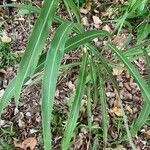Plant tufted, robust. Culms erect, 1.5–4 m tall, 6–15 mm in diam., unbranched, nodes usually glabrous, or uppermost sometimes bearded. Leaves cauline, congested; leaf sheaths longer than internodes, overlapping, glabrous, pilose at throat; leaf blades linear, flat, tough, 20–85 × 0.5–4 cm, glabrous, midrib prominent, margins scabrid, base rounded, apex acuminate; ligule 1–3 mm, densely pilose on back. Panicle oblong or elliptic, dense, 20–50 cm; axis 25–45 cm. Racemes numerous, 10–30 cm, appressed or ascending, glabrous, scaberulous; rachis internodes puberulous, nodes glabrous; lower pedicel 1–3.5 mm, upper pedicel 2.5–8 mm. Spikelets 2.5–4(–6) mm, awned; callus hairs 4–6 mm, white, spreading, as long as the spikelet; glumes subequal, membranous, golden brown, 2.5–4(–6) mm, margins pilose near apex, veins obscure, apex acuminate; lower lemma lanceolate, hyaline, 3–3.5 mm, veinless, pilose; upper lemma similar to lower, 2–2.5 mm; awn geniculate, 5–6(–10) mm; upper palea a small hyaline scale. Anthers 3, 1–1.5 mm. Caryopsis oblong, ca. 1.5 mm.
More
A coarse erect grass 1 to 3 m high. It spreads 1.5 m wide. It keeps growing from year to year. It spreads to 1 m wide. The stems are erect, slender and flowering. The leaves are pale green and fine. They form clumps and curve over. The leaves can be 90 cm long and have silver midribs. The flowers are tiny and dark brown to green. They occur in erect shoots at the end of the stalk. Flowers are not produced in cooler places.
A tropical plant. It will grow on most soils. It needs an open sunny position. It is damaged by drought but can tolerate frost. When repeated fires occur, this grass frequently occupies an area to the almost entire exclusion of other vegetation. It occurs in abundance at medium and high altitudes especially in the Mountain Province of Luzon in the Philippines. It suits hardiness zones 6-9. In Sichuan and Yunnan.
More
Moist soils in meadows, of lowland Japan. Slopes, valleys and grassy places in China. Often dominant on open slopes in Fiji, where it can form dense thickets at elevations from sea level to 900 metres.
Moist soils in meadows, of lowland Japan.

